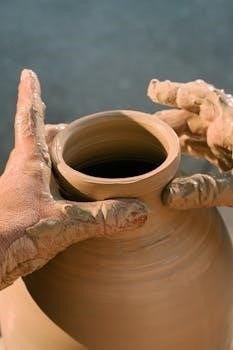Boss ME-80 User Manual⁚ A Comprehensive Guide
Welcome to the comprehensive guide for the Boss ME-80 multi-effects pedal! This manual provides an in-depth look at its features, functions, and operational tips. Whether you’re a beginner or experienced guitarist, this guide will help you unlock the full potential of your ME-80.
ME-80 Overview and Features
The Boss ME-80 is a powerful multi-effects guitar pedal designed for both live performance and studio use; It combines a wide range of flagship-quality BOSS COSM amps and effects into a compact, battery-powered unit. The ME-80 offers a diverse selection of tones, from classic overdrives to modern high-gain amps.
One of the key features of the ME-80 is its intuitive interface, which allows for easy tweaking of sounds on the fly. The pedal features dedicated footswitches for instant on/off control of individual effects, as well as expression pedal for real-time parameter manipulation. In manual mode, the ME-80 functions like a collection of stompboxes, with each category acting as an individual effect.
The ME-80 also boasts a memory mode, which allows users to store and recall custom patches. With BOSS Tone Studio software, users can further customize their tones and download new patches from the BOSS Tone Central library. The ME-80’s USB connection enables seamless integration with computers for recording and editing.
Overall, the ME-80 offers robust functionality in a compact, durable design, catering to diverse musical styles and performance settings; Its versatility and ease of use make it a popular choice among guitarists worldwide.
Understanding the ME-80’s Specifications
Delving into the specifications of the Boss ME-80 provides a clearer picture of its capabilities and limitations. The ME-80 utilizes a 24-bit AD/DA conversion, ensuring high-quality audio processing. Its sampling rate is 44.1 kHz, which is standard for digital audio.
The ME-80 offers a wide range of effects, including overdrives, distortions, compressors, delays, reverbs, and modulation effects. It also features COSM amp models, which simulate the sound of various classic and modern amplifiers. The number of simultaneous effects can vary depending on the specific effects being used.
The ME-80’s memory capacity allows for storing a certain number of user patches. Its power supply requires a 9V DC adapter or six AA batteries for portable use. The pedal’s dimensions are approximately 17.7 inches (W) x 9.1 inches (D) x 2.8 inches (H), and it weighs around 7 lbs with batteries.

Connectivity options include a standard 1/4-inch input for the guitar, 1/4-inch outputs for connecting to an amplifier or recording device, and a USB port for connecting to a computer. Understanding these specifications helps users optimize their setup and make informed decisions about how to use the ME-80 in their rig.
Navigating the Owner’s Manual
The Boss ME-80 owner’s manual is a comprehensive resource for understanding and utilizing the pedal’s many features. The manual is typically structured with a table of contents, allowing users to quickly locate specific topics of interest. It begins with an overview of the ME-80’s functions, including its various modes and effects categories.
The manual provides detailed explanations of each effect, including parameters that can be adjusted to shape the sound. It also covers how to save and load user patches, which are custom combinations of effects settings. The section on connectivity explains how to connect the ME-80 to different types of equipment, such as amplifiers, recording interfaces, and computers.
A troubleshooting section addresses common issues that users may encounter, offering solutions and guidance. The manual also includes diagrams and illustrations to aid in understanding the pedal’s layout and functions. It’s recommended to carefully read the manual before using the ME-80 to ensure proper operation and avoid potential problems.
Additionally, the manual may include safety precautions and maintenance tips to prolong the life of the pedal. By thoroughly navigating the owner’s manual, users can maximize their enjoyment and effectiveness with the Boss ME-80.
Downloading the Manual in PDF Format
Accessing the Boss ME-80 user manual in PDF format is a convenient way to have a digital copy readily available on your computer, tablet, or smartphone. To download the manual, begin by visiting the official Boss website. Navigate to the “Support” or “Downloads” section of the site, where you can search for the ME-80 specifically.
Once you locate the ME-80 product page, you should find a link to download the owner’s manual in PDF format. Click on the link, and your browser will typically prompt you to save the file to your desired location on your device. The PDF manual can then be opened with any PDF reader application, such as Adobe Acrobat Reader, which is available for free download.
Having the manual in PDF format allows you to easily search for specific keywords or topics, zoom in on diagrams, and print out sections as needed. It’s also a useful backup in case you misplace the physical copy of the manual that came with your ME-80. Always ensure you are downloading the manual from the official Boss website to ensure you have the correct and up-to-date version.

Furthermore, some third-party websites may also offer the ME-80 manual for download, but exercising caution and verifying the source is advisable to avoid downloading potentially harmful files.
Exploring Manual Mode
Manual Mode on the Boss ME-80 transforms the multi-effects unit into a collection of individual stompboxes. This mode offers a hands-on, intuitive experience, allowing guitarists to adjust settings on the fly with physical knobs and footswitches. In Manual Mode, each section of the ME-80—such as compressor, overdrive, distortion, modulation, delay, and reverb—functions as a separate effect pedal.
To engage Manual Mode, simply press the Memory/Manual pedal on the ME-80. The green LED will illuminate, indicating that you are now in Manual Mode. Each footswitch then corresponds to a specific effect category, enabling you to turn effects on or off instantly. The knobs above each footswitch allow for real-time tweaking of parameters, such as drive, tone, level, and modulation rate.
Manual Mode is ideal for guitarists who prefer the immediacy and flexibility of traditional stompboxes. It allows for quick adjustments during live performances, making it easy to dial in the perfect tone for any song or section. Experiment with different combinations of effects and settings to discover your unique sound. Remember that the settings you use in Manual Mode are not saved unless you store them in a memory location.
This mode is perfect for those who enjoy tweaking their sound as they play, offering a dynamic and responsive playing experience.
Utilizing Memory Mode
Memory Mode on the Boss ME-80 allows users to store and recall custom sound settings, known as patches. This mode is ideal for guitarists who need to switch between different tones quickly and efficiently during live performances or recording sessions. The ME-80 features numerous memory locations, allowing you to save a wide variety of customized sounds.
To engage Memory Mode, simply press the Memory/Manual pedal on the ME-80 until the green LED turns off. In Memory Mode, the footswitches are used to select different patches. Each patch contains the settings for all the effects in the ME-80, including amp models, overdrive, modulation, delay, and reverb.
Creating and saving patches is straightforward. First, dial in your desired sound using either Manual Mode or by adjusting the parameters within a selected memory location. Once you are satisfied with the sound, press and hold the desired footswitch to save the settings to that location. The ME-80 will indicate that the patch has been saved.
Memory Mode provides seamless transitions between different sounds, making it an invaluable tool for any guitarist seeking versatility and convenience. Experiment with creating patches for different musical styles and song sections to maximize the potential of the ME-80.
Connecting to BOSS Tone Studio
BOSS Tone Studio is a powerful software application that enhances the functionality of the ME-80 by providing a user-friendly interface for editing and managing patches. Connecting your ME-80 to BOSS Tone Studio unlocks a range of features that simplify sound customization and organization.
To connect your ME-80 to BOSS Tone Studio, you will need a standard USB cable. First, download and install the BOSS Tone Studio software from the BOSS website. Once installed, connect your ME-80 to your computer using the USB cable. Ensure that the ME-80 is powered on.
Launch the BOSS Tone Studio application. The software should automatically detect your ME-80. If it does not, verify that the USB cable is securely connected and that the ME-80 is powered on. You may also need to install the appropriate USB drivers, which can be found on the BOSS website.
Once connected, BOSS Tone Studio allows you to visually edit patch parameters, download new patches from the BOSS Tone Central library, and back up your existing patches. The software provides a clear and intuitive way to fine-tune your sounds and manage your ME-80’s memory.
Using the USB Connection
The USB connection on the Boss ME-80 offers more than just connectivity to BOSS Tone Studio. It serves multiple crucial functions, enhancing the overall usability and integration of the device with your digital workflow. Beyond patch management and editing, the USB port enables audio interfacing capabilities, allowing you to record directly into your computer.
When connected via USB, the ME-80 can function as an audio interface, sending processed or dry guitar signals to your DAW (Digital Audio Workstation). This eliminates the need for a separate audio interface, streamlining your recording setup. The ME-80 also allows for audio from your computer to be mixed with the guitar signal output.
To use the ME-80 as an audio interface, connect it to your computer via USB and select it as the input and output device in your DAW’s audio settings. You can then record your guitar tracks directly into your software, utilizing the ME-80’s effects and amp simulations.
Additionally, the USB connection facilitates firmware updates, ensuring your ME-80 is always running the latest software version. Regular updates can improve performance, add new features, and fix potential bugs. Check the BOSS website periodically for available updates.
Troubleshooting Common Issues
Encountering issues with your Boss ME-80 is a common experience, but most problems can be resolved with simple troubleshooting steps. One frequent issue is a lack of sound. First, check all cable connections, ensuring your guitar, amplifier, and ME-80 are properly connected. Verify that your guitar’s volume knob is turned up and that the ME-80’s output level is appropriately set;
Another common problem is unexpected changes in tone. This can often be attributed to accidental engagement of effects or incorrect settings. Make sure you are in the intended mode (Manual or Memory) and that the footswitches are not inadvertently activated. Review the current patch settings to ensure they align with your desired sound.
If you experience issues with the USB connection, ensure that the correct drivers are installed on your computer. Visit the BOSS website to download and install the latest drivers for your operating system. Also, verify that the ME-80 is selected as the audio input and output device in your recording software.
If problems persist, consider performing a factory reset. This will restore the ME-80 to its default settings, eliminating any potential configuration errors. Refer to the owner’s manual for instructions on how to perform a factory reset.
Accessing Support and Updates
Ensuring your Boss ME-80 operates at its best requires access to reliable support and staying up-to-date with the latest software and firmware. BOSS provides a wealth of resources to assist users with their ME-80, including online support, software updates, and community forums.
The official BOSS website is the primary hub for all support-related information. Here, you can find the latest owner’s manuals, frequently asked questions (FAQs), and troubleshooting guides. The website also hosts the BOSS TONE STUDIO software, which allows you to manage and customize your ME-80’s patches.
Regularly check the BOSS website for firmware updates. These updates often include bug fixes, performance improvements, and new features. Updating your ME-80’s firmware can significantly enhance its functionality and stability.
If you encounter issues that cannot be resolved through online resources, consider contacting BOSS customer support. They can provide personalized assistance and guide you through more complex troubleshooting steps. Additionally, the BOSS community forums are a valuable resource for connecting with other ME-80 users, sharing tips and tricks, and finding solutions to common problems.

By leveraging these support and update resources, you can ensure your ME-80 remains a reliable and powerful tool in your musical arsenal.
Finding Patches and Custom Tones
One of the greatest strengths of the Boss ME-80 is its versatility in creating and utilizing a wide array of tones. Finding and managing patches can greatly expand your sonic palette. Fortunately, there are several avenues for discovering new and exciting sounds.
BOSS Tone Central is a fantastic resource for downloading free, professionally designed patches created by top guitarists. These patches cover various musical styles and genres, offering a great starting point for your own experimentation.
The BOSS TONE STUDIO software allows you to easily browse, download, and manage patches from BOSS Tone Central. You can also create your own custom tones from scratch, tweaking every parameter to your exact liking. The software provides a visual interface for editing, making it easier to dial in your desired sound.
Online communities and forums dedicated to the ME-80 are another excellent source for finding user-created patches. Many guitarists share their custom tones and settings, allowing you to explore a vast library of sounds. Experimenting with these patches can inspire new ideas and help you discover unique sonic textures.
Remember to back up your favorite patches regularly to avoid losing them. With a little exploration, you can unlock the full tonal potential of your ME-80.
Comparing the ME-80 with Similar Multi-Effects Pedals
The Boss ME-80 stands out in the crowded market of multi-effects pedals, but understanding its strengths compared to similar units is crucial. Competitors like the Line 6 Pod Go, and the HeadRush Prime offer different approaches to tone creation and workflow.
The ME-80 excels in its user-friendly interface with dedicated knobs for real-time tweaking, appealing to players who prefer a traditional stompbox feel. In contrast, the Line 6 Pod Go and HeadRush Prime utilize digital interfaces with screens, offering deeper editing capabilities but potentially steeper learning curves.
Sound quality is subjective, but the ME-80 boasts a wide range of high-quality COSM amp models and effects. The Pod Go and HeadRush Prime offer amp modeling and effects as well, with each having unique sonic characteristics.
Connectivity is another key consideration. The ME-80 includes USB for recording and patch management. Pod Go and HeadRush Prime offer more comprehensive connectivity options.
Ultimately, the best multi-effects pedal depends on individual needs and preferences. The ME-80 is a strong choice for guitarists who value ease of use, a versatile range of tones, and a durable, gig-ready design.


